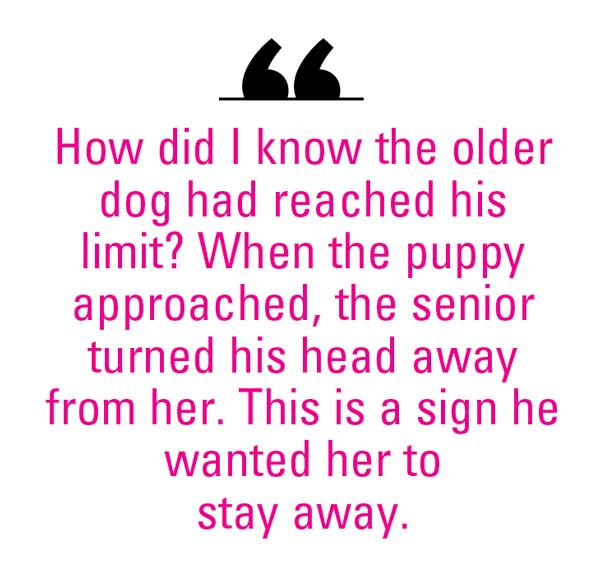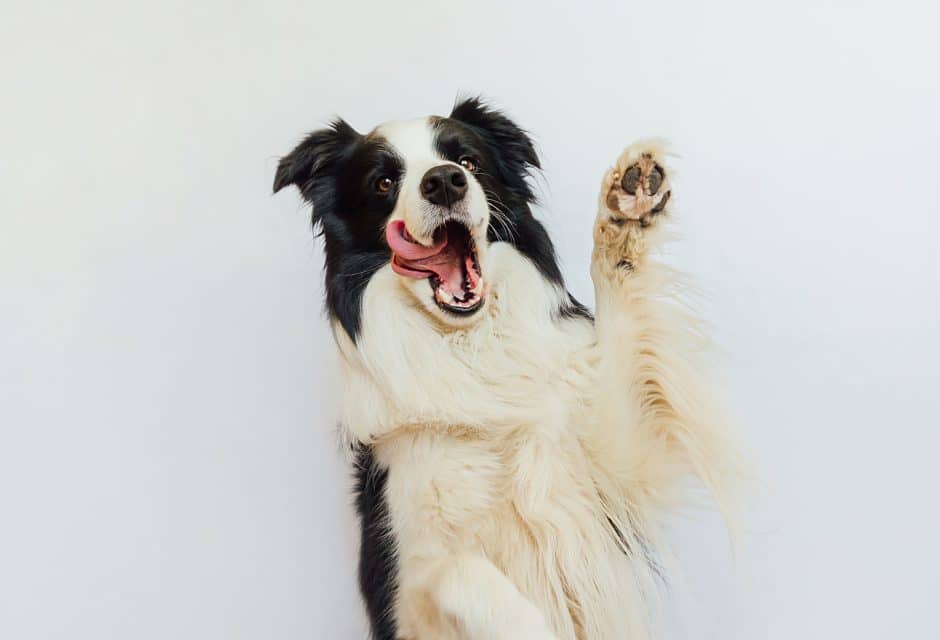

Your Dog Is Talking—Are You Listening?
How to read your dog’s calming signals and when to intervene in situations that are causing your dog stress
It was my first time meeting a new client and her puppy. Her older dog was trying to get my attention but the puppy kept intervening.
“Puppy getting on the other dog’s nerves, right?” I asked.
“Not so much. He’s amazingly tolerant of her,” she replied.
“Well, he’s about had enough,” I said. Just then, the older dog snapped. The puppy yipped and scrambled away.
“How did you know he was going to do that?” my client asked, surprised. “Do you talk Dog or something?”
“He showed me,” I responded. “Dogs talk to us all the time, you just need to learn how to listen.”
How did I know the older dog had reached his limit? When the puppy approached, the senior turned his head away from her. This is a sign he wanted her to stay away. She kept coming, and started gnawing on his ear. He turned farther away, showing the whites of his eyes—what trainers and behaviourists call “whale eye”—and lifting a lip. All signals he had had enough. The puppy happily continued chomping on his ear. The older dog then growled and snapped at her. She then understood his message, and backed away accordingly. If she had respected his earlier signals, he wouldn’t have escalated to the snap. Puppies often need lessons in understanding Dog, too!

Here are some common calming signals. Has your dog ever exhibited these?
The Head Turn
This can also be a full body turn, so your dog’s back is to the other dog, person or item. You might see this when another dog rushes your dog, or when the vacuum cleaner comes near him.
The Lip Lick
You might see this if you are scolding your dog – he may lower his head and start licking his lips. Take this in context—if you’re dangling a treat in front of your dog’s nose and he licks his lips, he’s probably just indicating he’s hungry.
The Yawn
Another one to take in context. Pup just wake up from a nap? He’s just sleepy. But if a toddler is fast approaching him, reaching for his ears, and he yawns, it’s likely a calming signal.
The Play Bow
In this pose, the dog’s rear will be up while his front end is low on the ground. This is an invitation to play, as he is making himself smaller and less potentially frightening. Social dogs often play bow to try to get other dogs to play with them.
Freezing
The dog will be completely still. Not even his tail will move. When a new dog enters a dog park, you’ll often see him freeze while the existing dogs check him out. This can indicate to the other dogs that he is not a threat. It can also be a serious indication of elevated arousal or stress. For example, a dog who guards bones, food or other objects may freeze just before he lunges to bite.
Walking In A Curve
Walking directly towards something, head on, is an assertive behaviour. Walking in a curve is less threatening. Ever get exasperated with your dog and yell at him to come inside the house? You may notice he approaches at a curve. This can make you angrier, thinking he’s taking the long way around, but he actually could be trying to diffuse a stressful situation.
If your dog displays clusters of calming signals, take note of what’s going on in his environment. Is he trying to make friends with someone? Is something bothering him? Calming signals that are ignored can often escalate. What starts out as a head turn, lip lick and yawn can grow to a growl, snap or bite. In the case of the toddler approaching a dog exhibiting calming signals, you’d definitely want to intervene. By learning what your dog is communicating, you’ll be able to better understand him, and make the world less stressful for him. You’ll probably find he’s glad you started listening!
Teoti Anderson, CPDT-KA, KPA-CTP, is a professional dog trainer and author of The Dog Behavior Problem Solver, Ultimate Guide to Dog Training, Puppy Care and Training, and more. She hosts the Get Pawsitive Results radio show on Pet Life Radio and educates pet parents and other trainers on canine behaviour through popular webinars and workshops.
Have you listened to your dog's signals, but he still gets stressed out in certain situations? Then check out these Modern Dog approved stress relievers!
Join the newsletter and never miss out on dog content again!
"*" indicates required fields
By clicking the arrow, you agree to our web Terms of Use and Privacy & Cookie Policy. Easy unsubscribe links are provided in every email.





